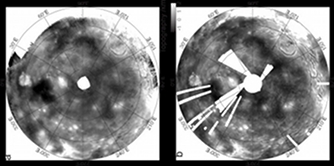Major Discoveries by Venus Express: 2006-2014
3. Spinning Venus is slowing down
Venus Express discovered that surface features were not quite where they should be, evidence that Earth's cloud-covered neighbour spins a little slower than previously measured. Using the VIRTIS instrument at infrared wavelengths to penetrate the thick cloud cover and study the surface, scientists discovered that some features were displaced by up to 20 km from where they should be.
Over its four-year mission, NASA's Magellan orbiter was able to watch surface features rotate beneath it, allowing scientists to determine that the length of a day on Venus was 243.0185 Earth days. However, the landforms seen by Venus Express some 16 years later could only be lined up with those observed by Magellan if the length of the Venus day is on average 6.5 minutes longer.
Scientists have looked at the possibility of this change arising from short-term, random variations in the length of a Venus day, but have concluded that these should average themselves out over time. On the other hand, atmospheric models have shown that the planet may have weather cycles stretching over decades, which could lead to equally long-term changes in the rotation period.
These detailed measurements from orbit are helping scientists determine whether Venus has a solid or liquid core, which will help our understanding of the planet's formation and how it evolved.
If Venus has a solid core, its mass must be more concentrated towards the centre. In this case, the planet's rotation would react less to external forces. The most important of those external forces is associated with the dense atmosphere and high velocity winds.
This is one of the major discoveries made by Venus Express during the last eight years. Read more on the following pages:
| Major discoveries by Venus Express: 2006-2014 |
|
#5. Snow on Venus? |
|
#6. Ozone layer |
|
#7. Water loss |



